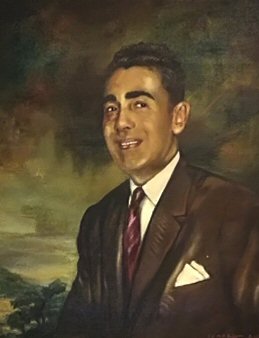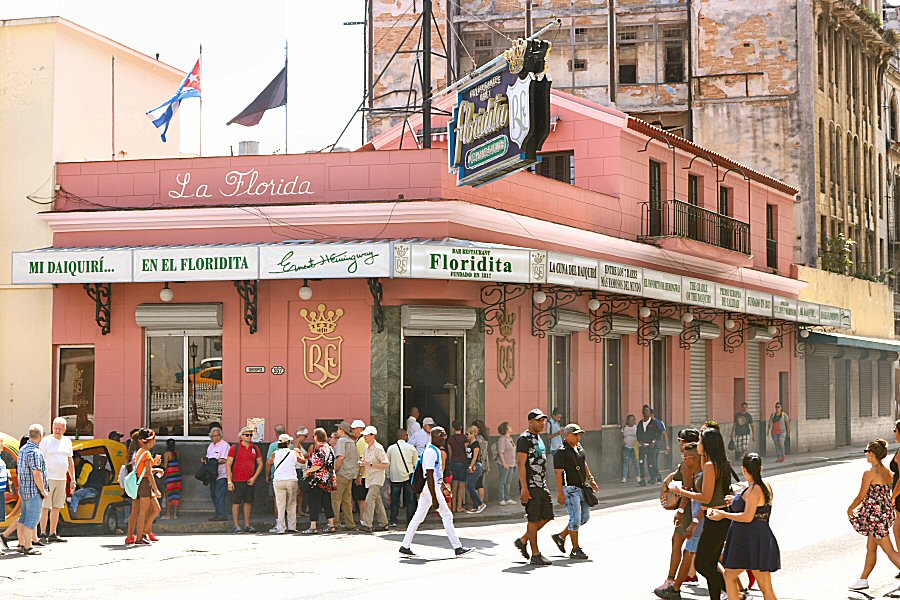
The Floridita Bar is located on the
Obispo street #557, where it intersects with the Avenida Bélgica, just a few blocks from El Capitolio.

The legendary bar El Floridita, the spiritual home of the frozen daiquiri, is one of the main tourist attractions in Havana that increased his fame by its regular, the well-known American writer Ernest Hemingway.
HISTORY
The bar was opened under the name
of La Piña de Plata (Silver Pineapple) in 1817. It occupied
the current localization, i.e. the corner of the Obispo and
the Monserrate streets (current Avenida Bélgica), just a few
blocks from El Capitolio. Initially, it was a dim, tiny
Spanish style bodega (cellar). It was not a popular place,
even though the steady flow of business owners, soldiers,
artists etc. around.
Following the Spanish-American War
in 1898, there began a fascination for all American things.
In 1910, the Catalan Narciso Sala Parera and his brother,
extended the bar towards the Monserrate street and added the
restaurant area to the building, by transforming the rundown
bodega into a modern place with a clean and comfortable
atmosphere. The restaurant was managed by a French chief.
The waiters and the bartenders wore coveted red jackets; a
feature that we still see at the cantineros (bartenders) of
El Floridita. The brothers choose an American name for their
business: La Florida. However, the name was quickly
converted into El Floridita. In 1918 Salas Perera sold his
premises to the Catalan Constantino Ribalaigua Vert that was
working there as a waiter, and then as a cantinero (bartender)
since 4 years.
 Constantino Ribalaigua Vert,
nicknamed as El Grande Constante (the Great Constant), was a
foresighted person. He learned the new cocktail, the Daiquri,
from the immortal bartender Emilio Gonzalez (known as
Maragato) that was working in the nearby Hotel Plaza.
However, instead of copying the preparation of the cocktail,
he tinkered endlessly mixing the ingredients to find the
best combination of the new drink. Thus, he created at least
four different versions of the daiquiri. When he discovered
that the infinitely crushed ice kept the cocktail slush
and cool, he created the blend that we know today:
the frozen daiquiri. He brought an ice machine from the
United States, the Flak Mark chipper, and prepared a metal
box with holes on the bottom to keep the crushed ice in good
condition for longer time. He added five drops of Marrasquino (Marrasquino or Maraschino is a liqueur
obtained from the distillation of Marasca cherries) to the
Pagliuchi's initial formula, calling it Daiquiri Floridita,
and used crushed ice in form of tiny pieces, like a frappé.
He used an electric mixer instead of the hand shaker,
because he gave importance to the exact shaking time. He
filled the stemmed cocktail glasses with ice to chill them,
before he served the cocktail in the same glass. It was by
far the most important to stick to the proportion of the
ingredients of the daiquiri (number 4 or Daiquiri Floridita).
Constantino Ribalaigua Vert,
nicknamed as El Grande Constante (the Great Constant), was a
foresighted person. He learned the new cocktail, the Daiquri,
from the immortal bartender Emilio Gonzalez (known as
Maragato) that was working in the nearby Hotel Plaza.
However, instead of copying the preparation of the cocktail,
he tinkered endlessly mixing the ingredients to find the
best combination of the new drink. Thus, he created at least
four different versions of the daiquiri. When he discovered
that the infinitely crushed ice kept the cocktail slush
and cool, he created the blend that we know today:
the frozen daiquiri. He brought an ice machine from the
United States, the Flak Mark chipper, and prepared a metal
box with holes on the bottom to keep the crushed ice in good
condition for longer time. He added five drops of Marrasquino (Marrasquino or Maraschino is a liqueur
obtained from the distillation of Marasca cherries) to the
Pagliuchi's initial formula, calling it Daiquiri Floridita,
and used crushed ice in form of tiny pieces, like a frappé.
He used an electric mixer instead of the hand shaker,
because he gave importance to the exact shaking time. He
filled the stemmed cocktail glasses with ice to chill them,
before he served the cocktail in the same glass. It was by
far the most important to stick to the proportion of the
ingredients of the daiquiri (number 4 or Daiquiri Floridita).
The cocktail daiquiri was intended
by the Italian engineer Giacomo Pagliuchi and the American
engineer Jennings Cox in Playa Daiquirí, a beach close to
Santiago de Cuba, in 1898, and Emilio González was the first
to bring it to Havana, but daiquiri is immortalized by
Constantino Ribalaigua Vert.
When the US Congress prohibited
the production, sale and consumption of alcohol in 1920, the
rum factories, particularly the Bacardí Rum Factory, started
with the campaign, promoting Cuba as a tropical island ideal
for the people that want to escape from the restriction of
alcohol consumption in USA. The efficient tactics of this
strategy, such as the mailing of the postcards that
illustrate the allure of the Havana nights with the Bacardí
rum cocktails, and the encouragement of a major airline
company the US customers by phrases like “to fly to Cuba and
to bath in Bacardí rum”, turned out satisfactory and
American tourists flocked to the bars of Havana. It was a
time, when the Floridita bar-restaurant reached
international fame due its cocktails, including the
daiquiri, and its excellent service.
The daiquiri became more popular
over time, becoming one of the favorite drinks of the Cuban
people and an emblematic drink of the island. Its formula
transmitted from bartender to bartender with slight
modifications. In 1939, when Ernest Hemingway was staying in
Ambos Mundos Hotel that is about 750 meters away from El
Floridita, he discovered the daiquiri. He frequented the bar
and used to drink daiquiri almost every day. It is said that
once he drank 13 double daiquiries in one setting. In one of
his visits, he told to Constant, now his good friend, that
the daiquiri would be better without sugar and with double
rum, hence a special drink, the Papa Doble, would carry his
name since then, Papa (Pope) Hemingway. Hemingway increased
the fame of the daiquiri with a phrase that attracted many
tourists: "Mi mojito en La Bodeguita, mi daiquirí en La
Floridita (My mojito in La Bodeguita, my daiquiri in La
Floridita)”. His sentence is framed and hang on the wall. Hemingway didn’t give up visiting El Floridita,
even when he started to live outside of Havana, in Finca
Vigía.
Over the time, the bar became a school for bartenders that want to be specialized in cocktails prepared with rum. In 1953, the Esquire Magazine declared El Floridita as one of the seven most famous bars in the world. In 1991 the bar was completely renovated, without disturbing all its original elements. In 1992, El Floridita received the "Best of the Best Five Star Diamond" award from the American Academy of Gastronomic Sciences.

